
Where Are Jeans Made?
Jeans are produced all over the world, but most consumer denim comes from Asia or South America---the Philippines, China and Honduras all produce jeans. Some premium brands may be produced domestically or in Europe, but these usually command higher prices to cover increased labor costs. Jeans are made by both hand and machine, with large factories able to produce about 2,500 pairs per day, according to Jeans Info.
Pre-Production and Cutting
To start, the jeans are designed for a certain type of denim, with a pattern created for that particular variety of textile. A stretch denim will need a different sort of construction than a nonstretch denim, so patterns must be specific to the fabric to get the desired fit. After the pattern is produced and sloped to make a whole range of sizes, the pattern goes to the cutting floor. Once the pattern is placed on the denim, the many layers of fabric are cut into pieces for legs, pockets, waistband and accents. The pieces are bundled together by component, with up to 100 layers of cuts ready to go.
Sewing and Finishing
The jeans head over to the sewing machines, where they're sewn by workers on incredibly fast industrial machines. An industrial machine can sew thousands of stitches a second, so these employees must be highly skilled to avoid injury in their haste. According to Jeans Info, an average worker can piece together a whole pair of jeans in about 15 minutes. Afterward, the stitched garments are washed in industrial machines and processed for color. This can mean bleaching, dyeing or stone washing, as well as other embellishments. When this step is completed, workers apply branding labels and tags, ending the process by bagging the finished garment in a plastic sack.
Related Articles
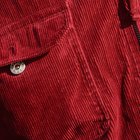
What Is the Difference Between Denim & ...
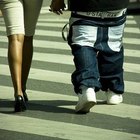
How To Make Baggy Jeans

How to Get the Stiffness Out of ...

The Correct Socks for Men's Jeans
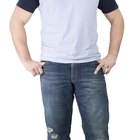
How to Get Rid of Whiskers on Jeans

Kids' Fashion of the 1980s

Denim vs. Denim Blends

How to Wash Wrangler Jeans

Difference in Misses, Juniors, and ...

How to Rip Jeans at the Bottom

Materials Used to Make Jeans
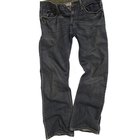
How to Get the Wrinkled Look in Your ...

How to Create Pencil Edging on a Veil

How to Get Fuzz Out of Polyester

How to Make '80s Jeans

How to Make Khaki Pants Darker With Dye

Levis Jeans Label History
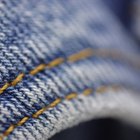
How to Bleach a Whole Pair of Jeans

What is a Gored Skirt?
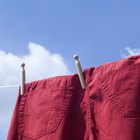
How to Dye Faded Clothes
References
Writer Bio
Gigi Starr is a freelance fashion writer. She previously served as the blog editor for a major online fashion blog and has more than a decade of backstage experience in the beauty and high fashion industries. She has worked for businesses like an internationally renowned theatrical touring company and events such as the Mercedes-Benz N.Y.C. Fashion Week.
Photo Credits
2009 Evil Erin / Creative Commons